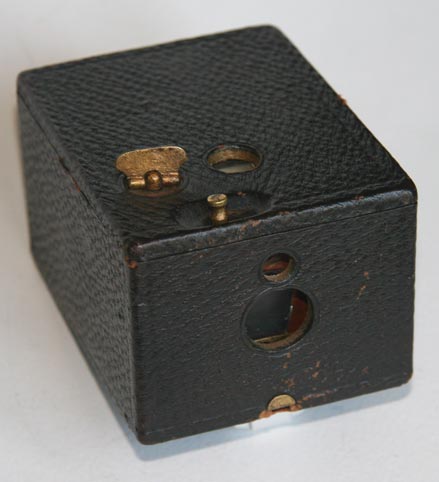
George Eastman courtesy www.biography.com.
Born in New York State in 1854, George Eastman's father died when he was young, forcing him to drop out of high school and go to work. In 1881, George bought his first camera, a bulky affair which required a chemist's knowledge to operate. A glass plate had to be coated with liquid emulsion. Then a photograph had to be taken before the liquid dried. George purchased a tent to develop his outdoor photos as he took them.
In 1877, Eastman patented his invention of gelatin emulsion which did not dry as easily as its predecessor. Three years later, he opened his own photography studio. In 1885, Eastman invented what would probably be his most important innovation: rolls of film. His film would be dry, transparent and flexible, making it much more practical than the plates and emulsion system. This made photography faster and enabled the photographer to capture multiple images.

Kodak pocket camera circa 1895 courtesy www.vieilalbum.com.
By 1888, Eastman picked a name out of the air, Kodak, and his company was born. Customers could buy a Kodak camera for $25 which would take 100 pictures. They could in turn send in the roll of film to be developped for $10.
Kodak's pocket camera, which appeared in 1895, had 100 sold by the following year, due in large part to Eastman's advertising campaign. His slogan "You press the button, we do the rest" could be found on bulletin boards, in newspapers and periodicals.

upload.wikimedia.org
By 1900, Eastman unveiled his new Brownie camera which sold for only $1.00 and produced 2 1/4 inch square pictures. No longer a tedious process, the owner of a camera could now take "snapshots" until his heart was content. One writer explained that Eastman "made the camera as convenient as the pencil". Now that it was easy to use and inexpensive to purchase, everyone was buying the new apparatus. A 1902 ad announced: "A vacation without a camera is a vacation wasted."
Kodak, based in Rochester, New York, was growing by leaps and bounds. With his profits, Eastman built a 50-room mansion. Sadly he never had a wife or children to share it with. But he did share much of money, opening the Eastman School of Music and donating 20 million to M.I.T.
Sources: www.kodak.com
en.wikipedia.org

Eastman's mansion courtesy redbubble.net.
No comments:
Post a Comment